|
| Links | This is a common woodland associated species. Often abundant in bottomlands in early spring. In females, the relatively large size, and the distinctive propodeum can be helpful in identification. The lateral carinae that define the rear face are nearly straight and go all the way to the top. The males look quite different than the females, with very dull, densely pitted scutums, a highly reticulated propodeum, and almost no hairs on the underside of the abdomen. In some cases males can have extensive red on the basal tergites.
- Hosts
|
80x5 -
240x3 -
240x4 -
320x1 -
320x2 -
320x3 -
640x1 -
640x2
Set display option above.
Click on
images to enlarge. |
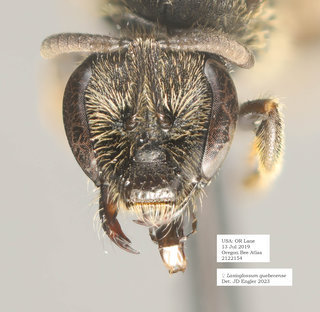
© Copyright source/photographer
· 9
Lasioglossum quebecense, female, head, OBA |
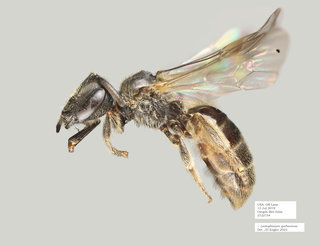
© Copyright source/photographer
· 9
Lasioglossum quebecense, female, lateral, OBA |
|
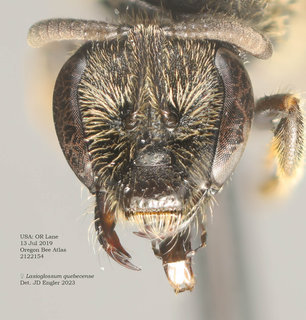
© Copyright source/photographer
· 9
Lasioglossum quebecense, female, head, OBA |
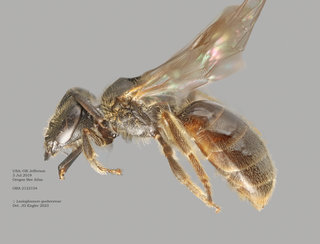
© Copyright source/photographer
· 9
Lasioglossum quebecense, female, lateral |
|
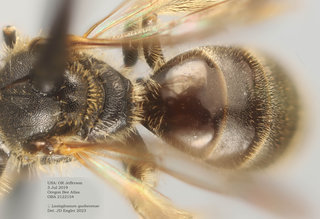
© Copyright source/photographer
· 9
Lasioglossum quebecense, female, OBA |
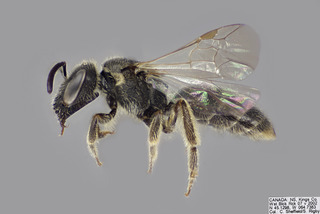
© Copyright Laurence Packer 2014
· 7
Lasioglossum quebecense FEM CFP comp |
|
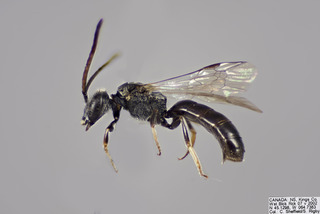
© Copyright Laurence Packer 2014
· 7
Lasioglossum quebecense MALE CFP comp |
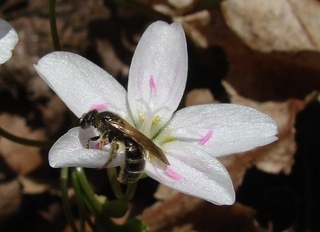
© Copyright John Ascher, 2006-2014
· 6
Lasioglossum quebecense |
|
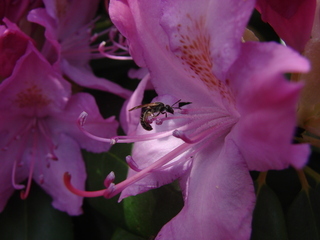
© Copyright John Ascher, 2006-2014
· 4
Lasioglossum quebecense, sweat bee |
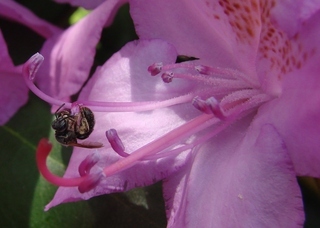
© Copyright John Ascher, 2006-2014
· 4
Lasioglossum quebecense, sweat bee |
|
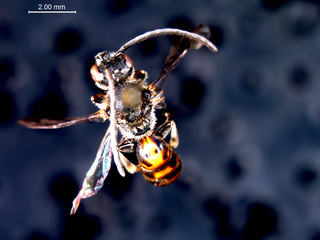
Rob Snyder · 1
Lasioglossum quebecense, red male |
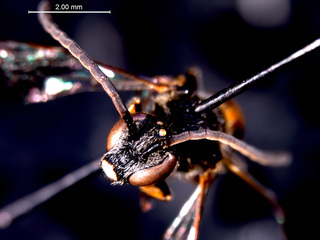
Rob Snyder: Pennsylvania State University · 1
Lasioglossum quebecense, red male head |
|
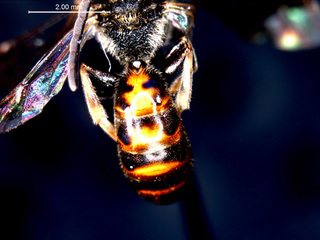
Rob Snyder: Pennsylvania State University · 1
Lasioglossum quebecense, red male abdomen |
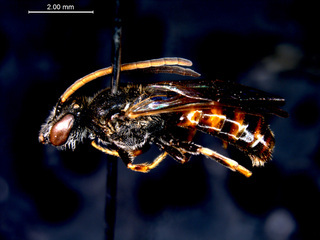
Rob Snyder: Pennsylvania State University · 1
Lasioglossum quebecense, red male side |
|
Overview |
Reprinted with permission from: Mitchell, T.B. 1960 Bees of the Eastern United States. North Carolina Agricultural Experiment Station Technical Bulletin No. 141.
FEMALE�Length 7 mm.; black; pubescence white, rather thin except on thorax laterally; length and breadth of head equal; clypeus slightly rounded, projecting about two- thirds below suborbital line; eyes only very slightly convergent below; cheeks subequal to eyes in width; lateral ocelli slightly nearer margin of vertex than to eyes; face above antennae dull, very densely and finely punctate, punctures of face below antennae quite sparse, the surface tessellate except on clypeus apically; area between eyes and ocelli densely punctate, vertex medially dull, obscurely sculptured, the cheeks finely striate above, becoming somewhat more coarsely so medially, but ventral portion quite smooth; scutum densely tessellate between rather fine and shallow punctures, these well separated in central portion of disc, becoming very close laterally; scutellum dull, punctures well separated on each side of a slight, median impression where punctures are closer; pleura with rather low but coarse reticulations above, becoming relatively smooth but densely tessellate below; dorsal area of propodeum somewhat shining, rather coarsely striate, posterior face quite smooth, bordered laterally with low but quite distinct carinae which reach the dorsal margin; wings subhyaline, veins and stigma testaceous; tegulae dark anteriorly except for the hyaline anterior border, becoming more ferruginous posteriorly; legs dark except for the apical, reddened, tarsal segments; hind basitibial plate small, triangular, acute; abdominal terga rather dull, punctures exceedingly minute and obscure, not visible except at very high magnification, terga 2 and 3 with thin and inconspicuous, apical fasciae slightly evident laterally, without distinct basal fasciae, discal pubescence extremely short, thin and entirely pale.
MALE�Length 6-8 mm.; black; labrum, apical half of clypeus and legs in part, yellowish; pubescence whitish, very short and thin; length and breadth of head equal; clypeus rather narrow and protuberant, projecting about two thirds below suborbital line; eyes rather strongly convergent below; mandibles simple, not greatly elongated, entirely dark; labrum transverse, without a median projection, entirely yellow; cheeks slightly narrower than eyes; lateral ocelli slightly nearer margin of vertex than to eyes; basal segment of flagellum very short, not much longer than broad, but somewhat longer than pedicel, the second and following segments elongate, fully twice as long as broad, ferruginous below, piceous above, face above antennae, dull, densely rugoso-punctate, becoming somewhat shining below between the fine and rather close punctures, these becoming more coarse and sparse on apical half of clypeus; area between eyes and ocelli dull, roughened, the vertex medially dull, with obscure transverse striations, cheeks finely striate; scutum tessellate between fine and quite close punctures, these somewhat separated near center posteriorly but very closely crowded laterally; scutellum dull, very closely punctate throughout, with a very slight median impression; pleura dull and rather finely rugose above, becoming somewhat more shining and with obscure reticulations below; dorsal area of propodeum rather coarsely rugoso-striate, posterior face coarsely reticulate, the lateral carinae rather indefinite; wings subhyaline, veins and stigma brownish-testaceous; tegulae rather dark ferruginous, with a broad, yellowish-hyaline, anterior border; legs dark basally, tibiae dark except for basal and apical yellowish spots, front tibiae yellowish anteriorly, all of tarsi yellowish; abdominal terga somewhat shining, punctures very fine but rather deep and distinct, scattered on basal tergum, but close basally on the following terga, becoming sparse or absent apically, with only very obscure and indefinite, basal, whitish fasciae evident laterally on terga 2 and 3; apical margin of sternum 5 straight, 6 rather broadly rounded; gonostylus short, truncate, only thinly pubescent, the ventral, retrorse lobe quite short, attenuated apically, thinly pubescent along outer side.
DISTRIBUTION � Newfoundland and Nova Scotia to Minnesota, south to Georgia; April to September.
FLOWER RECORDS�Acer, Aruncus, Azalea, Barbarea, Berteroa, hex, Melilotus, Rubus, Solidago, Taraxacum, Vaccinium and Viburnum. Brittain and Newton (1934) record it also on Kalmia, Malus and Prunus.
|
|
|
Identification |
This is a large species, 7.5-8mm, in the male the rear face of the propodeum with lateral raised lines that rise up to form a v-shaped fork at the top almost reaching the rim of the triangle, the triangle striations weak, widely spaced, not raised very high, reaching to the rim, grey appressed short hairs of metanotum go from narrow on the sides and increase to fill the entire width in the center, similar hair on outside of pronotum, but the only Newfoundland specimen had only a restricted amount. Holotype seen.
John Ascher adds the following additional guides to the identification of this species:
1) This species has (weak) apical hair bands which Lasioglossum supposedly lack; these are lacking in species with which it could be confused such as L. cinctipes, rufitarse, etc.
2) It has a tesselate (not smooth) scutum unlike L. cintipes/truncatum
3) It is very close to L. comagenense but has a longer face, more southeren range, subtly different hair patterns and sculpturing, etc.
Extracted from: Gibbs, J., Packer, L., Dumesh, S. and Danforth, B. N. 2013. Revision and reclassification of Lasioglossum (Evylaeus), L. (Hemihalictus) and L. (Sphecodogastra) in eastern North America (Hymenoptera: Apoidea: Halicidae). Zootaxa 3672 (1). Pp 1-116.
Diagnosis. Female L. quebecense can be recognised by the combination of head long (L/W ratio = 1.00–1.03) (Fig.
43F); mesepisternum finely rugulose (as in Fig. 76D); inner metatibial spur pectinate, teeth longer than width of
rachis (Fig. 5O); propodeum with lateral carina distinct, extending to dorsal margin, oblique carina strong (Fig.
79E); T1 dull due to microsculpture; and T1–T3 usually with dense apicolateral fimbriae (Fig. 81C). In the east, L.
quebecense are most similar to L. boreale, L. comagenense, and L. seillean, which all lack dense apicolateral
fimbriae on T1–T3 (Figs. 81A, 81B, 81D). Lasioglossum boreale and L. comagenense have short teeth on the inner
metatibial spur, not exceeding the width of the rachis (Figs. 5M, 5N) and T1 polished due to lack of microsculpture
(Figs. 81A, 81B). Lasioglossum comagenense has a noticeably shorter head (L/W ratio = 0.93–0.96) (Fig. 43C).
The female of L. boreale has fine propodeal carinae (Fig. 79C). Lasioglossum quebecense is nearly
indistinguishable from L. seillean but averages larger in size (6.5–7.0 mm vs. 5.8–6.5 mm).
Male L. quebecense can be recognised by the combination of clypeus with yellow on distal half (Fig. 44F);
mandible short, not extending much beyond opposing clypeal angle; F2 long subequal to scape; propodeal lateral
carina strong; metasomal sterna nearly bare, hairs present but very short (as in Fig. 85A); S2–S3 with sparse
punctures (as in Fig. 88A); base of metatibia brown or with small yellow spot; and all basitarsi bright yellow (Fig.
66). Male L. quebecense often has the mesoscutum scabriculous-reticulate throughout, whereas in L. boreale, L.
comagenense, and L. seillean the mesoscutum is distinctly punctate medially, with well-defined interspaces. Males
of L. boreale and L. comagenense have a large yellow patch on the metatibial base (Figs. 54, 57). The unique shape
of the retrorse lobe (Figs. 87C, 87E), which is long, and strongly attenuated apically, is the most reliable character
for distinguishing L. quebecense males from those of L. boreale, L. comagenense, and L. seillean (Figs. 87A, 87B,
87D, 87F).
Redescription. FEMALE. Length 6.5–7.0 mm. Head length 1.82–1.95 mm. Head width 1.80–1.93 mm. Wing
length 5.2–5.7 mm. (n=5)
Colour. Head and mesosoma black. Antenna black, except ventral surface of flagellum reddish brown. Tegula
dark reddish brown. Legs dark brown, except medio- and distitarsi reddish brown. Wing membrane hyaline, faintly
dusky. Pterostigma testaceous. Metasomal terga black-brown, apical margins pale brown-testaceous.
Structure. Head long (L/W ratio = 1.00–1.03). Clypeus ¾ below suborbital line. Eyes convergent below (UOD:
LOD = 1.05–1.07). Gena subequal to eye width. Ocelli normal. Pronotum smoothly rounded. Protibial spur with
serrations as long as width of malus. Inner metatibial spur pectinate, teeth 3–7, basal teeth longer than width of
rachis. Propodeal lateral carina reaching dorsal margin, oblique carina high, separating dorsolateral slope from
posterior surface.
Pubescence. Head and mesosoma with sparse plumose hairs. Metafemoral scopa with dense plumose hairs.
Metasomal terga with relatively dense, medially-interrupted apical fimbriae. T1 with sparse, erect plumose hairs.
T2–T4 basally with sparse, tomentum. Metasomal sterna with plumose scopa.
MALE. Length 5.9–8.6 mm. Head length 1.67–2.13 mm. Head width 1.61–1.98 mm. Wing length 4.8–5.9
mm. (n=7)
Colour. Head and mesosoma black. Clypeus yellow apical half. Mandible brown. Labrum yellow. Antenna
black, except ventral surface of flagellum orange, less so on F10–F11. Legs dark brown, except tarsi yellow, bases
and apices of tibiae sometimes yellow, anterior surface of protibia sometimes yellow-testaceous. Wing membrane hyaline. Pterostigma orange-brown. Metasomal terga dark brown, pale brown apically; T1–T3 occasionally
yellow-orange.
Structure. Head long (L/W ratio = 1.03–1.08). Mandible short, reaching opposing clypeal angle.
Flagellomeres, except F1 elongate, F2 longer than F1 and pedicel combined. Eyes strongly convergent below
(UOD:LOD = 1.24–1.48). Gena clearly narrower than eye. Pronotum smoothly rounded. Propodeal lateral carina
reaching dorsolateral slope, contiguous with strong oblique carina.
Surface sculpture. Supraclypeal area imbricate, with relatively sparse punctures (i=1–1.5d). Gena and postgena
lineolate. Mesoscutum reticulate; punctures usually contiguous throughout, sometimes separated medially (i≤d).
Mesepisternum rugulose, weakly so ventrally. Metapostnotum anastomosingly rugose. Propodeum rugulose,
posterior surface rugose. Metasomal terga polished; punctures deep, close basally. T3–T6 apical impressed areas
impunctate.
Pubescence. Head and mesosoma with sparse plumose hairs. Face below antennal sockets with dense
tomentum, lower paraocular area obscured, supraclypeal area and clypeus partially obscured, clypeus bare on distal
half. Propodeum largely bare, with scattered plumose hairs. Metasomal terga nearly bare, with neither apical
fimbriae nor evident tomentum. Metasomal sterna nearly bare, with sparse, short, plumose hairs (≤1 OD).
|
|
|
Names | |
|
|
| Supported by | |
Updated: 2024-04-25 09:11:41 gmt
|